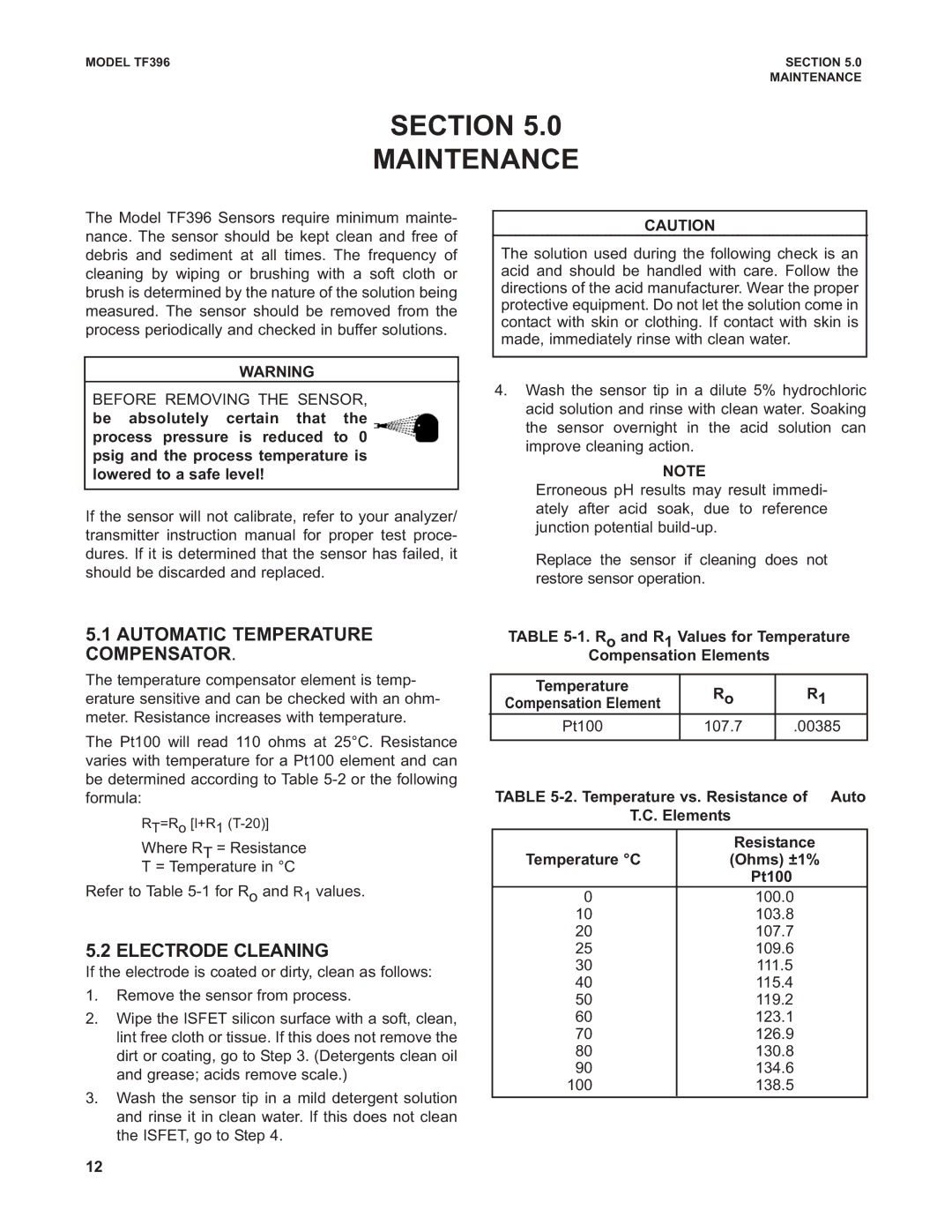
MODEL TF396 | SECTION 5.0 |
| MAINTENANCE |
SECTION 5.0
MAINTENANCE
The Model TF396 Sensors require minimum mainte- nance. The sensor should be kept clean and free of debris and sediment at all times. The frequency of cleaning by wiping or brushing with a soft cloth or brush is determined by the nature of the solution being measured. The sensor should be removed from the process periodically and checked in buffer solutions.
WARNING
BEFORE REMOVING THE SENSOR, be absolutely certain that the process pressure is reduced to 0 psig and the process temperature is lowered to a safe level!
If the sensor will not calibrate, refer to your analyzer/ transmitter instruction manual for proper test proce- dures. If it is determined that the sensor has failed, it should be discarded and replaced.
5.1AUTOMATIC TEMPERATURE COMPENSATOR.
The temperature compensator element is temp- erature sensitive and can be checked with an ohm- meter. Resistance increases with temperature.
The Pt100 will read 110 ohms at 25°C. Resistance varies with temperature for a Pt100 element and can be determined according to Table
RT=Ro [l+R1
Where RT = Resistance
T = Temperature in °C
Refer to Table
5.2 ELECTRODE CLEANING
If the electrode is coated or dirty, clean as follows:
1.Remove the sensor from process.
2.Wipe the ISFET silicon surface with a soft, clean, lint free cloth or tissue. If this does not remove the dirt or coating, go to Step 3. (Detergents clean oil and grease; acids remove scale.)
3.Wash the sensor tip in a mild detergent solution and rinse it in clean water. If this does not clean the ISFET, go to Step 4.
CAUTION
The solution used during the following check is an acid and should be handled with care. Follow the directions of the acid manufacturer. Wear the proper protective equipment. Do not let the solution come in contact with skin or clothing. If contact with skin is made, immediately rinse with clean water.
4.Wash the sensor tip in a dilute 5% hydrochloric acid solution and rinse with clean water. Soaking the sensor overnight in the acid solution can improve cleaning action.
NOTE
Erroneous pH results may result immedi- ately after acid soak, due to reference junction potential
Replace the sensor if cleaning does not restore sensor operation.
TABLE 5-1. Ro and R1 Values for Temperature
Compensation Elements
Temperature | Ro | R1 | |
Compensation Element | |||
|
| ||
Pt100 | 107.7 | .00385 | |
|
|
|
TABLE
T.C. Elements
| Resistance |
Temperature °C | (Ohms) ±1% |
| Pt100 |
0 | 100.0 |
10 | 103.8 |
20 | 107.7 |
25 | 109.6 |
30 | 111.5 |
40 | 115.4 |
50 | 119.2 |
60 | 123.1 |
70 | 126.9 |
80 | 130.8 |
90 | 134.6 |
100 | 138.5 |
|
|
12
